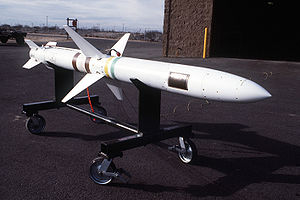| AGM-45 Shrike | |
|---|---|
 AGM-45 Shrike | |
| Type | Air-to-surface anti-radiation missile |
| Place of origin | United States |
| Service history | |
| In service | 1965–1992 |
| Wars | |
| Production history | |
| Designed | 1963 |
| Manufacturer | Texas Instruments and Sperry Rand/Univac |
| Produced | 1963-1982 |
| No. built | 18,500 |
| Specifications | |
| Mass | 390 pounds (177.06 kg) |
| Length | 10 feet (3.05 m) |
| Diameter | 8 inches (203 mm) |
| Wingspan | 3 feet (914 mm) |
| Warhead | 67.5 kg (149 lb) MK 5 MOD 1 (or MK 86 MOD 1) blast-fragmentation, or 66.6 kg (147 lb) WAU-9/B blast-fragmentation |
Operational range | 16 km AGM-45A,[3] 40 km AGM-45B[4][3] |
| Maximum speed | Mach 1.5 |
Guidance system | Passive radar homing |
| Accuracy | 20ft |
Launch platform | A-4 Skyhawk, A-6 Intruder, LTV A-7 Corsair II, F-100 Super Sabre, F-105 Thunderchief, F-4 Phantom II, Avro Vulcan (not regular service), F-16 Fighting Falcon, Kfir, Kilshon system |
AGM-45 Shrike is an American anti-radiation missile designed to home in on hostile anti-aircraft radar. The Shrike was developed by the Naval Weapons Center at China Lake in 1963 by mating a seeker head to the rocket body of an AIM-7 Sparrow. It was phased out by U.S. in 1992[1] and at an unknown time by the Israeli Air Force (the only other major user), and has been superseded by the AGM-88 HARM missile. The Israel Defense Forces developed a version of the Shrike that could be ground-launched with a booster rocket, and mounted it on an M4 Sherman chassis as the Kilshon (Hebrew for Trident).[1][5]
- ^ a b c "[9.0] Anti-Radar Missiles". Archived from the original on 21 November 2011. Retrieved 27 November 2011.
- ^ Spencer Tucker, The encyclopedia of the Arab-Israeli conflict: a political, social, and military history. A–F, Volume 1, 2008, ABC-CLIO, p. 685
- ^ a b "AGM-45 Shrike". weaponsystems.net. Retrieved 11 April 2018.
- ^ "AGM-45 "Shrike" Anti-Radiation Missile". af.mil. Archived from the original on 29 December 2017. Retrieved 11 April 2018.
- ^ "Kilshon". www.israeli-weapons.com. Retrieved 11 April 2018.